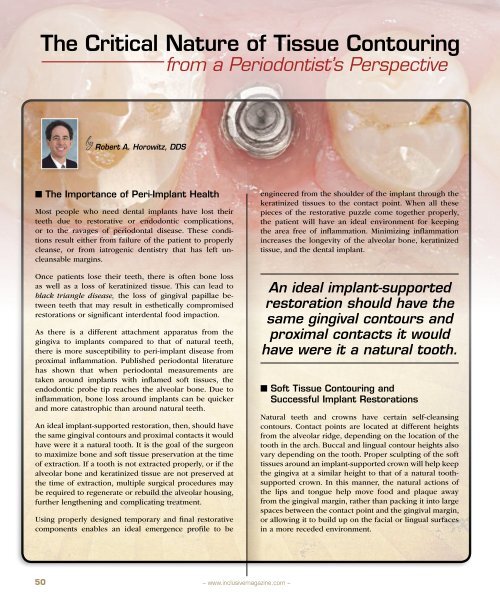PDF Download - Glidewell Dental Labs
PDF Download - Glidewell Dental Labs
PDF Download - Glidewell Dental Labs
You also want an ePaper? Increase the reach of your titles
YUMPU automatically turns print PDFs into web optimized ePapers that Google loves.
The Critical Nature of Tissue Contouring<br />
from a Periodontist’s Perspective<br />
by Robert A. Horowitz, DDS<br />
■ The Importance of Peri-Implant Health<br />
Most people who need dental implants have lost their<br />
teeth due to restorative or endodontic complications,<br />
or to the ravages of periodontal disease. These conditions<br />
result either from failure of the patient to properly<br />
cleanse, or from iatrogenic dentistry that has left uncleansable<br />
margins.<br />
Once patients lose their teeth, there is often bone loss<br />
as well as a loss of keratinized tissue. This can lead to<br />
black triangle disease, the loss of gingival papillae between<br />
teeth that may result in esthetically compromised<br />
restorations or significant interdental food impaction.<br />
As there is a different attachment apparatus from the<br />
gingiva to implants compared to that of natural teeth,<br />
there is more susceptibility to peri-implant disease from<br />
proximal inflammation. Published periodontal literature<br />
has shown that when periodontal measurements are<br />
taken around implants with inflamed soft tissues, the<br />
endodontic probe tip reaches the alveolar bone. Due to<br />
inflammation, bone loss around implants can be quicker<br />
and more catastrophic than around natural teeth.<br />
An ideal implant-supported restoration, then, should have<br />
the same gingival contours and proximal contacts it would<br />
have were it a natural tooth. It is the goal of the surgeon<br />
to maximize bone and soft tissue preservation at the time<br />
of extraction. If a tooth is not extracted properly, or if the<br />
alveolar bone and keratinized tissue are not preserved at<br />
the time of extraction, multiple surgical procedures may<br />
be required to regenerate or rebuild the alveolar housing,<br />
further lengthening and complicating treatment.<br />
Using properly designed temporary and final restorative<br />
components enables an ideal emergence profile to be<br />
engineered from the shoulder of the implant through the<br />
keratinized tissues to the contact point. When all these<br />
pieces of the restorative puzzle come together properly,<br />
the patient will have an ideal environment for keeping<br />
the area free of inflammation. Minimizing inflammation<br />
increases the longevity of the alveolar bone, keratinized<br />
tissue, and the dental implant.<br />
An ideal implant-supported<br />
restoration should have the<br />
same gingival contours and<br />
proximal contacts it would<br />
have were it a natural tooth.<br />
■ Soft Tissue Contouring and<br />
Successful Implant Restorations<br />
Natural teeth and crowns have certain self-cleansing<br />
contours. Contact points are located at different heights<br />
from the alveolar ridge, depending on the location of the<br />
tooth in the arch. Buccal and lingual contour heights also<br />
vary depending on the tooth. Proper sculpting of the soft<br />
tissues around an implant-supported crown will help keep<br />
the gingiva at a similar height to that of a natural toothsupported<br />
crown. In this manner, the natural actions of<br />
the lips and tongue help move food and plaque away<br />
from the gingival margin, rather than packing it into large<br />
spaces between the contact point and the gingival margin,<br />
or allowing it to build up on the facial or lingual surfaces<br />
in a more receded environment.<br />
50<br />
– www.inclusivemagazine.com –

















